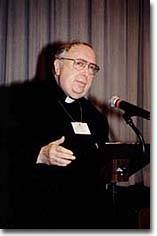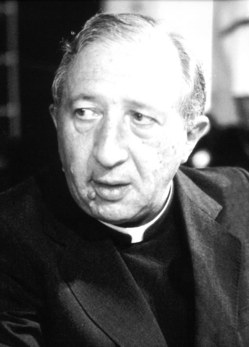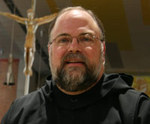Earlier today I was speaking with my friend, Father Meinrad Miller, a Benedictine monk of Saint Benedict’s Abbey (Atchison, KS) and he told me he wrote this article for the local Catholic diocesan newspaper on his experience with the movement we both closely follow, Communion and Liberation. What Father Meinrad says in his article is applicable to all of us. It’s reprinted here for education of us all. Let me know what you think of it.
Seven years ago
this fall an event happened here at Benedictine College that would change my
life. My college roommate, B.J. Adamson, had told me over the years about a
Catholic movement he had discovered back in Denver: Communion and Liberation
(CL). B.J. would often tell me about the method of the movement’s dynamic
founder, Monsignor Luigi Giussani (October 15, 1922-February 22, 2005), and of
a friend of the movement here in the United States Monsignor Lorenzo Albacete.
Cardinal Stafford, then the Archbishop of Denver, had spoken highly of CL.
In
September 2002 we hosted a presentation here at Benedictine College on one of
Giussani’s key books, The Religious Sense. The presentation included talks by Monsignor
Lorenzo Albacete, a physicist,
theologian and good personal friend of Pope John Paul II; Major David
Jones, an army officer who had been attracted to the Catholic faith after
watching a show on EWTN with Raymond Arroyo in which Monsignor Albacete was
interviewed about Monsignor Giussani; Dr. Eduardo Echeverria, currently a
philosopher at Sacred Heart Seminary in Detroit; and Mike Eppler, the Youth
Minister for the Evansville, Indiana Diocese.
What appealed to me about this
first presentation was that everything said that evening deepened my own appreciation
of being a Benedictine monk. Giussani’s method affirms that the encounter with
Christ is possible to all people. Over the coming years we would have further
book presentations here at the college on the writings of Monsignor Giussani.
Each time I would grow in my fascination for the message of Christ as relevant
and part of life today. It was only later that I learned that St. Benedict was
the patron saint of the movement. At one time Monsignor Giussani had written to
some Benedictine monks near Milan, Italy. In part he said: Christ present! The
Christian announcement is that God became one of us and is present here, and
gathers us together into one body, and through this unity, His presence is made
perceivable. This is the heart of the Benedictine message of the earliest
times. Well, this also defines the entire message of our Movement.
Perhaps
Monsignor Giussani’s fascination with St. Benedict began as a young seminarian
for the Archdiocese of Milan. The Archbishop during Monsignor Giussani’s
seminary training was Blessed Ildephonse Schuster, O.S.B., the saintly
Benedictine. The same year that Blessed Ildephonse Schuster died, 1954, would
mark a major change in the life of Giussani as well.
While riding on a train
for vacation in 1954, Giussani noticed from the conversation of the youth on
the train that there was little interest in Christianity. Much of the
discussion focused on the ideologies of the day, including Marxism. Giussani
asked the new Archbishop’s permission to leave his work as a seminary professor
and begin to teach high school students.
The conversion on the train reminded
me of Blessed Mother Teresa’s own conversion. This past year I gave a seminar
to the Missionaries of Charity in Washington, D.C. As I was reading about
Blessed Mother Teresa I could not help but notice a similarity with Monsignor
Giussani. Mother Teresa was also on a train on September 10, 1946, going for
her yearly retreat in the mountains of India. It was on the train that she had
a mystical experience in which she would experience the great thirst God has
for souls. Not just for water but for men and women to experience the real thirst
of God’s love for them.
Eight years after Blessed Mother Teresa’s experience on
the train in 1946, Monsignor Giussani would have his experience on the train in
1954. Years later he would also reveal the depth of this conviction when, in
front of Pope John Paul II and hundreds of thousands of people gathered at St.
Peter’s square on Pentecost Sunday, 1998, he would say: Existence expresses
itself, as ultimate ideal, in begging. The real protagonist of history is the
beggar: Christ who begs for man’s heart, and man’s heart that begs for Christ.
Whether
one looks at our humanity in terms of Christ thirsting for us in the words of
Blessed Mother Teresa, or Christ begging for man’s heart, in the words of
Monsignor Giussani, the same dynamic is present. Christ desires us to encounter
Him as a present reality, not just a distant myth.
On September 10, 2004,
Cardinal Ratzinger, the future Pope Benedict XVI, would describe his own
meeting with Monsignor Giussani in the early 1970s, and Communion and
Liberation:
It was an interesting discovery for me; I had never heard of this
group (Communion and Liberation) until that moment, and I saw young people full
of fervor for the faith, quite far from a sclerotic and weary Catholicism, and
without the mentality of “protest”-which considers all that was there before
the Council as totally superseded-but a faith that was fresh, profound, open
and with the joy of being believers, of having found Jesus Christ and His
Church. There, I understood that there was a new start, there was really a
renewed faith that opens doors to the future.
This same experience is relived
today by groups in the region in Kansas City, Benedictine College, KU, and
Wichita that meet weekly to follow the method of Monsignor Luigi Giussani.
Father
Meinrad Miller, O.S.B. is the Subprior of Saint Benedict’s Abbey, and Chaplain of
Benedictine College in Atchison, KS
This article was recently published in The Catholic key, the Catholic newspaper of the Diocese of Kansas City-St Joseph, MO.



Tony Blair? And you want anyone to take Communion and Liberation seriously?
Joan, As a matter of fact, I do hope that more people will take seriously the method of CL. In this article, Fr Meinrad did not speak about Mr Blair; you obviously are talking about the Rimini Meeting. There, the Rimini Meeting is not sponsored by CL but is the personal initiative of some people who follow the movement. Perhaps the distinction is flimsy but it is true. It is a meeting of people with a variety perspectives, exploring various points of knowledge, understanding and faith. The Dali Lama addressed the Meeting as well as many other notable non-Christians. Catholics don’t share the Lama’s theology but we would accept a philiosophy built on the dignity of the human person, the struggle for freedom and peace, no? I suppose if the Holy Father could meet with people who disagree with the Church, then Blair could come to Rimini have a public dialogue. I certainly do not have an appreciation for Blair’s liberal tendencies when it comes to his practice of Catholic faith and the political order but I have a desire for him (and all of us) to meet Christ. Perhaps he can meet Christ at Rimini.
Thanks for reading the blog and writing. Much appreciated.
Imagine the following scenario:
Scribe or Pharisee: “How can anyone take that Rabbi Jesus seriously – He associates with tax collectors, prostitutes and sinners.”
We who claim to follow Christ can have exactly the same attitude that the Scribes and Pharisees had – who were, BTW, very devout and pious people!
And so my question is: Are we called to be salt of the earth and since salt makes a person thirsty it seems that we are called to make people “thirsty” for Christ. And how can we do that if we never meet them? I.e., how can Christ reach these people if we (we Catholic Christians) are not there?
Pax to all.
How interesting that your friend discovered CL from Denver. Several years ago, after having read a great deal about CL, and having followed the blog of Maj. David Jones for a while, I decided to try and find a CL community in Denver. This was about 4 years ago, well after Stafford left for Rome.
I couldn’t find them. I asked friends attending the seminary here, and they didn’t know where they were either. I never did find them, though I heard a rumor that some of them attend the Eastern-Rite Divine Liturgy.
And while the spirituality of CL still really appeals to me, I’m not sure that it would work well with my family situation. We have 9 kids. I might be interested in getting the eldest involved in GS, but I don’t think we have that here.
Ben-
There is an increasingly vibrant CL community in Denver… many of them are families with lots of kids! Also, I think GS is in the works… If you read this, send me an email at orri6475@stthomas.edu and I can get you connected if you’re not already.
-Joey
Watch this video of a presentation he did in Tucson in 2008 and judge CL for yourselves!
What did you think?
PAX